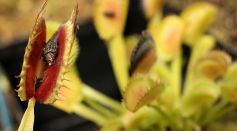Tags: Charles Darwin

Darwinian Evolution Possibly Taking Place 4 Times Faster Than We Know

Evolution of Carnivorous Plants: Here's How These Leafy Organisms Became Meat Lovers

Tropic Birds More Colorful Than Avians Away from Equator, Studies Suggest

Single Gene APETALA3-3 Contributes to the Sudden Evolutionary Change in Such Species

130-Million-Year-Old Fossilized Flower Bud Could Answer Charles Darwin's 'Abominable Mystery' of How They Evolved

Newly Found Sponge-Like Structures Could Push Animal Evolution Back by Several Hundred Million Years
Ant Social Parasitism: Plot Twists in the Origins and Evolution of These Tiny Animals Revealed
Famed Darwin's Arch Rock Formation in Galapagos Islands Collapses Due to Natural Erosion
Charles Darwin’s Mystery Animal: Solved!
Tuatara: Insight On Darwin's Theory Of 'Living Fossils'
The Energy for a New Crawl—Galápagos Tortoises Feast on Invasive Plants for a New Foraging Technique
The Curious Case of Birds—How Evolution Has Led to Less Differences Than Charles Darwin Thought
Most Popular

Glaciers Are Melting Fast: Climate Change Impact Driving Sea-Level Rise Worldwide

Can the World Run Out of Water? Water Scarcity Science and Climate Impact Explained

Solar Maximum 2026: Inside the Sunspot Cycle and Solar Activity Forecast Astronomers Are Watching

Volcanic Warning Signs: How Magma Movement Reveals Eruption Prediction Clues for Geologists





